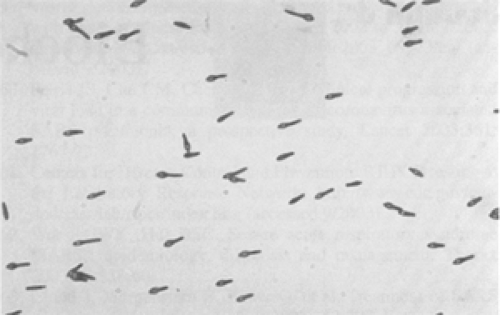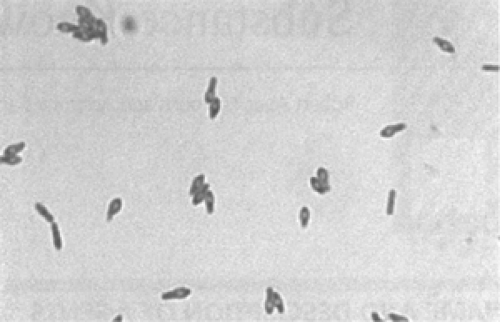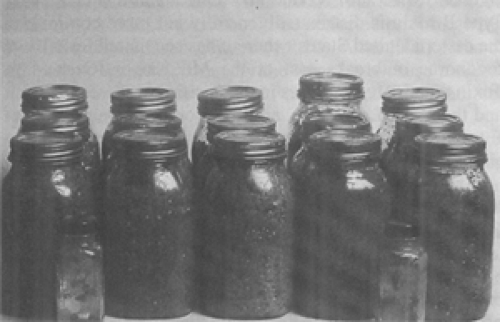Botulinum: The Most Toxic Substance Known
Robert Abar Timmons
Anthony Carbone
NAME AND DESCRIPTION OF AGENTS
Botulinum toxin is a potent protein neurotoxin that causes the paralytic condition known as botulism. This toxin has the distinction of being the most potent substance by weight known to science (1, 2), requiring only 0.001 μg/kg body weight to kill 50% of animals in laboratory studies (3). Botulinum toxin type A is 15,000 and 100,000 times more toxic by weight than VX and sarin nerve gases, two of the well-known organophosphate nerve agents, respectively (3). It further has the singular distinction of being both a substance approved for medical treatment and a feared agent of biological terrorism. Currently, botulinum toxin is approved by the U.S. Food and Drug Administration (FDA) for use in treating neuromuscular disorders such as blepharospasm, strabismus, and torticollis. It also has several off-label uses, such as treatment of wrinkles, migraine headaches, chronic low back pain, stroke, traumatic brain injury, achalasia, and various dystonias (4). It should be noted that the licensed preparation is sufficiently dilute, containing only about 0.3% and 0.005% of the estimated human lethal inhalational and oral doses, respectively, that it is impractical for use as a bioterror weapon (4).
Botulinum toxin is elaborated by Clostridium botulinum, a spore-forming, gram-positive, anaerobic bacterium that is found throughout the world in soil and marine environments (5). Botulism is a neuroparalytic illness that results from the action of botulinum toxin. It typically begins with cranial nerve involvement and progresses caudally to involve the extremities (5). Because of botulinum toxin’s extreme potency and lethality, ease of production and transport, and need for prolonged resource-intensive care of victims, it was one of the first agents to be considered for use in modern times as a biological weapon in warfare (6). Though the United States has renounced any further research in developing botulinum toxin as a biological weapon, concern remains that other countries or terrorist groups may still attempt to employ it (6). Currently it is one of six potential biological warfare agents listed by the Centers for Disease Control and Prevention (CDC) as a Category A agent, designating it as a high-priority biological agent of concern (7).
A German scientist, Justinius Kerner, first discovered botulism in 1793. Kerner traced the disease to spoiled sausage, a result of the crude means of sausage preservation at the time, and he named the substance “wurstgift” or sausage poison. This led to the origin of the term “botulism,” as the Latin root word for sausage is botulus. C. botulinum was first described by Emile van Ermengem in 1897
after isolating the microbe while investigating a foodborne outbreak in Ellezelles, Belgium (8, 9). Foodborne botulism remains the most common form of disease in adults. However, plant rather than animal products are the more common vehicles for poisoning, typically as a result of unregulated “home canning” or other improper food handling (8).
after isolating the microbe while investigating a foodborne outbreak in Ellezelles, Belgium (8, 9). Foodborne botulism remains the most common form of disease in adults. However, plant rather than animal products are the more common vehicles for poisoning, typically as a result of unregulated “home canning” or other improper food handling (8).
In humans, botulinum toxin inhibits the release of acetylcholine, leading to a characteristic flaccid paralysis (10). Four distinct forms of botulism can occur, depending on the mode of acquisition of the toxin. Cases may be classified as (a) foodborne botulism, resulting from ingestion of food contaminated with C. botulinum and containing preformed toxin (10); (b) wound botulism, caused by toxin produced in a wound contaminated by C. botulinum(10); (c) infant botulism, which is due to the endogenous production of toxin in the intestine of infants following ingestion of germinating spores of C. botulinum(10); or (d) inhalational botulism, a man-made form that results from inhaling aerosolized botulinum toxin (4). Intestinal botulism, a variation of infant botulism, can also occur in children or adults and is represented by those cases in which no food vehicle can be identified, there is no evidence of wound botulism, and there exists the possibility of intestinal colonization in a person older than 1 year of age (10).
Inhalational botulism has been demonstrated experimentally in primates (11), has been attempted by bioterrorists in recent times (12, 13), and has been the intended outcome of at least one country’s specially designed missiles and artillery shells (4, 14, 15). However, there has only been one report of three individuals suffering from accidental inhalational botulism, having occurred in three veterinary personnel in West Germany in 1962. All three individuals had detectable Type A botulinum toxin in their serum following exposure to reaerosolized botulinum toxin while disposing of lab animals whose fur was coated with aerosolized type A botulinum toxin (16).
THEORETICAL AND SCIENTIFIC BACKGROUND
C. botulinum is a species of four genetically distinct groups that have in common the production of antigenically distinct neurotoxin with a similar pharmacologic action but that otherwise would not be designated as a single species (4, 17, 18). C. botulinum organisms are straight to slightly curved, gram-positive (in young cultures), motile, anaerobic rods, 0.5 to 2.0 μm in width, and 1.6 to 22.0 μm in length, with oval, subterminal spores (8, 19). There are seven distinct toxin types of C. botulinum described (A, B, C1, D, E, F, and G), distinguished by the antigenic characteristics of the neurotoxins they produce (10). An eighth toxin type, C2, is not a neurotoxin but actually a cytotoxin of unknown clinical significance (5). Toxin types A, B, E, and in rare cases F cause human botulism (8). Types C1 and D cause disease in mammals and birds (5, 10). Type G, now called C. argentinense, has been associated with sudden death, but not with neuroparalytic illness, in a few patients in Switzerland (5). Additionally, the rare clostridial strains of C. baratii and C. butyricum also have the capacity to elaborate botulinum toxin (4, 5, 20,21,22) (Figs. 11-1 and Figs. 11-2).
Each of the seven active neurotoxins has similarity in structure and mechanism of action, producing a polypeptide of 150 kDa, which is activated by proteases subsequent to bacterial lysis (8). Active botulinum neurotoxin is a simple dichain polypeptide consisting of a 100 kDa heavy chain (H), which is the fragment involved in neurospecific binding and translocation into the nerve cell, and a 50 kDa light chain (L), responsible for intracellular catalytic activity (5, 8). The heavy and light chains are joined by a single disulfide bond (4, 23). The heavy chain is composed of an amino-terminal 50 kDa domain (HN) and a carboxy-terminal 50 kDa domain (HC) (8). The light chain is a zinccontaining
endopeptidase that blocks acetylcholine-containing vesicles from fusing with the terminal membrane of the motor neuron (4, 24).
endopeptidase that blocks acetylcholine-containing vesicles from fusing with the terminal membrane of the motor neuron (4, 24).
Neuronal cell intoxication involves four steps: (a) binding of the carboxy-terminal end of the heavy chain (HC) to polysialoganglioside receptors on the neuronal membrane, (b) endocytotic internalization of active toxin into endosome-like compartments, (c) membrane translocation facilitated by the amino-terminal half of the heavy chain (HN), and (d) enzymatic cleavage of SNARE proteins by the light chain (L), which prevents complete assembly of the synaptic fusion complex and thus blocks release of the neurotransmitter acetylcholine from synaptic terminals of the motor neurons in muscle (5, 8). The muscle is unable to contract in the absence of acetylcholine release (8, 25).
The light chain (L) of each neurotoxin type is a zinc-containing endopeptidase that is capable of cleaving a toxin-specific location of at least one of three proteins (4, 8). Botulinum toxin types A, C, and E cleave the protein SNAP-25 (= synaptosomal-associated protein of 25 kd); types B, D, F and G cleave the protein synaptobrevin; and type C cleaves the protein syntaxin (4). These three proteins are members of a group of proteins known as SNARE proteins, or soluble NSF-attachment protein receptor (4, 8). SNARE proteins are essential to the docking and fusion of synaptic vesicles with the presynaptic membrane (25).
As mentioned previously, botulinum toxins are the most toxic substances by weight known to science. The precise human lethal dose of botulinum toxin is not known but can be estimated from primate studies. The LD50H, or lethal dose to 50% of the human population exposed, for botulinum toxin has been estimated to be about 1 ng/kg (1, 6). By extrapolation, the lethal amounts of crystalline type A toxin for a 70-kg human would be approximately 0.09 to 0.15 μg intravenously or intramuscularly, 0.70 to 0.90 μg inhalationally, and 70 μg orally (4, 11, 26, 27, 28). All of the botulinum toxins are slightly less toxic by experimental models when exposure is by the pulmonary route, as estimates for the LD50 via inhalation is approximately 3 ng/kg based on experimental models (6, 29). The oral route of exposure to botulinum toxin appears to be 2 degrees of magnitude less toxic than the intravenous or intramuscular routes.
The most likely scenario for terrorist or biological warfare use of botulinum toxin is an intentional aerosol release, or possibly an attempt to contaminate a food or water source (3). There has never been a reported case of waterborne botulism (4, 8, 30, 31). Speculation has arisen that botulinum toxin may be used to contaminate a municipal water supply, but this scenario is not likely (4, 32). One reason is that botulinum toxin is rapidly inactivated by standard potable water treatments such as chlorination and aeration (4, 33). A second reason is that because of the slow turnover time of large capacity reservoirs, a comparable large inoculum of botulinum toxin would be required, and this would be technically infeasible to produce and deliver (4, 34). However, botulinum toxin may remain viable in untreated water or beverages for several days; therefore, these items should be investigated in the absence of other identifiable sources of a botulinum index case or outbreak (4, 33, 35).
The three primary forms of naturally occurring botulism are foodborne, wound infection, and infant or adult intestinal botulism. The U.S. incidence of botulism is typically fewer than 200 cases of all forms annually (8). Foodborne botulism is a rare entity, as there are on average approximately 9 to 10 outbreaks and a median of 24 total cases of this disease per year in the United States (8). From 1950 through 1996, there were 444 outbreaks and 1,087 cases of foodborne botulism recorded in the United States (8). Both the average number of outbreaks per year and the average number of cases per outbreak has remained stable throughout the last century (8). The single largest outbreak of foodborne botulism in the United States in the last century occurred in Michigan in 1977, in which there were 59 cases as a result of eating home-preserved jalapeño peppers at a restaurant (4, 36) (Figs. 11-3 and Figs. 11-4).
Of the 135 foodborne outbreaks in the United States from 1980 to 1996, toxin type A accounted for 54.1%, toxin type B for 14.8%, toxin type E for 26.7%, and toxin type F for 1.5% of these outbreaks, with 3.0% of the outbreak causes undetermined (4, 8). Toxin types C and D cause botulism in wildlife and domestic animals, though it is thought that humans are susceptible based on primate studies (4, 37,38,39). Toxin type G is produced by a bacterial species in South American soil and has never caused recognizable foodborne botulism (4, 40).
Nearly all states have reported at least one outbreak of foodborne botulism since 1950; however, over half (53.8%) of all outbreaks reported have occurred in just five western states (California, Alaska, Washington, Colorado, and Oregon) (8). The geographic distribution of foodborne botulism cases by toxin type is closely correlated with the distribution of organism types found in the environment. Type A toxin is predominant west of the Mississippi River, and has accounted for 85% of foodborne outbreaks in this area (4, 8). Type B toxin is distributed generally but more common in the eastern United States, where it has accounted for 60% of foodborne outbreaks east of the Mississippi River (4, 8). Toxin type E predominates in the Pacific Northwest, Alaska, and the Great Lakes area, and foodborne outbreaks of type E toxin are commonly associated with fish products, especially native Inuit and Eskimo foods (4, 5, 8).
Stay updated, free articles. Join our Telegram channel

Full access? Get Clinical Tree






